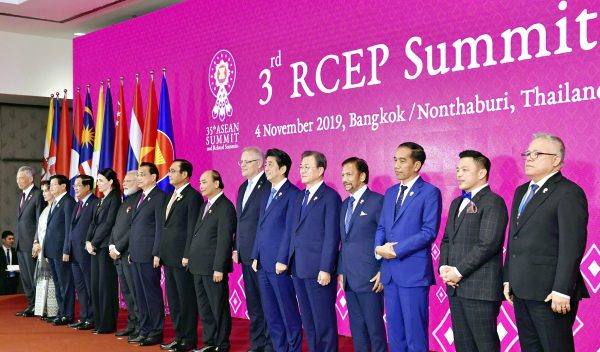Indonesia has played a significant role in the negotiations. As the seventh largest economy in the world — and the largest in ASEAN — it is in Indonesia’s interest to see this trade deal concluded. First, it will help Indonesia expand its market and integrate further into the global supply chain. Second, RCEP comes at the right time as it should complement the recently passed Omnibus Law in achieving structural reform in Indonesia. It is even more important given the lacklustre development in multilateralism and the disruption in global trade caused by the COVID-19 pandemic.
RCEP may serve as an umbrella to the many bilateral arrangements and ‘ASEAN pluses’ in the region. Its sheer size will help minimise potential spaghetti effects among its members through common sets of rules of origin that reduce complications in doing trade. In fact, there is potential for RCEP members to take advantage of the existing FTAs between members and non-members.
Indonesia can thus increase its participation in the global value chain, although its involvement is currently below that of many other RCEP members. One study found that Indonesia may even benefit from other members’ involvement in different trade deals. It estimates that spill over effects can increase Indonesia’s trade by more than 7 per cent through increased engagement with the regional and global supply chain. For among Indonesia’s top 11 trading partners, only the United States and India are not RCEP members.
RCEP should further improve Indonesia–ASEAN intra-trade relations on which Indonesia heavily relies. 25 per cent of Indonesia’s total exports went to ASEAN and 23 per cent of its total imports came from ASEAN in 2019, largely a result of eliminating the complexities related to rules of origin in the existing trade agreements involving ASEAN countries. Reducing regional trade barriers is a necessary step to sustain trade and uphold competition and efficiency. Increased trade flows are likely to induce more foreign direct investment (FDI). This is in line with repeated calls from President Joko Widodo for increased FDI inflows to Indonesia.
A tariff elimination schedule is a key feature of RCEP. The aforementioned study found that a 1 per cent cut in tariffs by RCEP members will increase Indonesia’s trade by more than 2 per cent on average, controlling for other factors.
But RCEP should not only focus on tariff elimination. Recently, trade inefficiency has been mostly caused by non-tariff barriers and behind-the-border constraints, such as weak institutions, bad government interventions and poor infrastructure. So while joining forces through RCEP, the members should prioritise collective regional development to sustain trade, complemented by domestic reforms in individual countries. This includes structural adjustments to eliminate obstacles to doing business — something that Indonesia has been trying to do.
There is criticism that the deal is not forward-looking enough. Instead of creating new trade, RCEP is deemed to only formalise existing trade within the region. RCEP has also been compared to the Comprehensive and Progressive Agreement for Trans-Pacific Partnership (CPTPP) and is seen to be less comprehensive and more focused on cutting tariffs and increasing market access. But that also means RCEP requires fewer political and economic concessions that may hamper trade and investment.
Another concern is China’s dominance of RCEP — especially after India’s withdrawal. But RCEP is not a China-led initiative. ASEAN started it and Indonesia led the negotiations.
That China will play a big role is not surprising. China has been ASEAN’s biggest external trade partner and investor for decades. In the first two quarters of 2020, China had a share of 18 per cent in ASEAN’s total trade, accounting for US$220.54 billion. ASEAN’s supply chains are also highly dependent on China’s manufacturing sector. Moreover, Indonesia’s trade with other countries such as the United States and the European Union has also been increasing.
The next step for Indonesia is ratification by parliament. Growing anti-trade sentiment in Indonesia may complicate this process. But the same parliament ratified the Indonesia-Australia Comprehensive Economic Partnership Agreement in February, so it will most likely also ratify RCEP.
Once RCEP takes effect, Indonesia should continue its support for multilateral trade reform. Together with the other members, Indonesia should ensure that RCEP serves as a way to keep the global trading system open. Domestically, the Indonesian government should also use this as momentum to resist calls for protectionism.
Arianto A Patunru is a fellow at the Arndt-Corden Department of Economics, Crawford School of Public Policy, the Australian National University.
Ira Aprilianti is an economist based in Jakarta.

